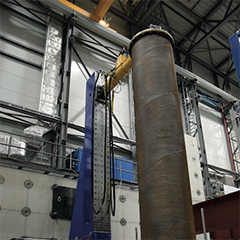Abstract: Larger wind turbines and increasing water depths are presenting industry with new challenges for the realisation of economical foundation systems. The issues confronting industry here are manifold and include not only the optimisation and validation of structures or soil-structure interaction models, but also the development of economical installation methods with mitigated noise levels.
-
Experimental validation of prediction models
Optimised calculation methods are required for the economical design of support or foundation structures. The engineer has a broad range of prediction models with different levels of complexity available for this purpose. During the design process, these models complement each other and can be categorised as semi-empirical models, analytical models, or numerical models.
The decision as to which of these models represents the engineering problem with sufficient accuracy is usually based on experience. All models have one thing in common though: Regardless of whether they are simple or complex, they have to be validated with the aid of physical experiments before they can be utilised.
A distinction is made here between small-scale, large-scale, and real-scale experimental tests. Since the load-bearing and deformation behaviour of the soil depends on the stress level, small-scale tests (scale 1:100 to 1:30) are often not sufficiently accurate to provide a realistic representation of the stiffness and load-bearing capacity of a foundation system. Real-scale experiments are very cost-intensive and often not fully controllable, however, and are therefore often unable to provide an adequate statistical basis.



























